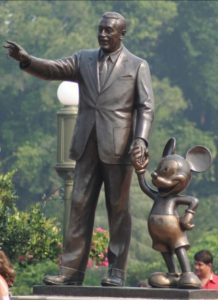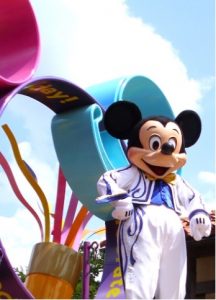When I first read the headline to this New York Times article, “Mickey’s Copyright Adventure: Early Disney Creation Will Soon Be Public Property,” I thought that Mickey Mouse would soon lose its copyright and enter the public domain. If Mickey Mouse were to enter the public domain, artists could use Mickey without fear of a copyright infringement lawsuit.
I learned from an IP survey course that copyrights created after January 1, 1978 typically last for the life of the author plus 70 years. However, the original Mickey Mouse was created before 1978, so a different set of rules applies.

Disney’s first use of the Mickey Mouse character appeared in 1928 in “Steamboat Willie,” a short film created by animator Ub Iwerks for Walt Disney. Walt Disney and Ub Iwerks created “Steamboat Willie” together, under the Disney company. In 1928, copyrights lasted for 28 years, with the option for renewal of another 28 years. As of 2023, Mickey Mouse was published almost 95 years ago. The copyright of the original Mickey Mouse character – as it appeared in “Steamboat Willie” – expires on January 1, 2024. So, what does this mean for Disney and how did the copyright last this long?
What is a copyright?
Someone can have copyright in an original work of authorship so long as it is fixed in a tangible medium and not statutorily barred. “Original work of authorship” requires that the work is not copied from someone else. A work must also be minimally creative and is not copyrightable if it is merely a word or phrase. Protection of a word or phrase is more likely to come from trademark law.
Some examples of original works of authorship that may receive copyright protection include literary works, musical works and accompanying words (i.e. lyrics), dramatic works and accompanying music, choreography, movies, sound recordings, and more.
Though copyright registration is not required for copyright protection, it is required for copyright infringement suits as a it provides the court a presumption of validity. Registration is useful if acquired within the first five years of publication because it constitutes prima facie evidence in court.
What is the Mickey Mouse copyright?
Disney released “Steamboat Willie” on November 18, 1928 and officially registered the Mickey Mouse character for copyright protection on December 16, 1928. This copyright prevents others from copying and using the likeness of Mickey Mouse without Disney’s permission. Disney therefore has the exclusive right to use the character in its creative works for the term of the copyright.
Additionally, Mickey Mouse is considered a “work made for hire” (“WMFH”) copyright. The Mickey Mouse copyright was created by an employee for his employer, the Walt Disney Corporation.

Could the (Steamboat Willie) Mickey have expired earlier?
The first federal copyright law came into existence in 1790. This law guaranteed protection of a copyright for 14 years, with an option for a renewal of another 14 years. Copyright law then changed in 1909, when copyright terms were extended to 28 years, with an option for a 28 year extension upon renewal. Under this law, Disney’s original Steamboat Willie Mickey Mouse would have expired in 1984.
However, Disney lobbied for copyright law to extend copyright terms by 20 years in the 1970’s. Disney’s lobbying efforts led to the Copyright Act of 1976, which allowed copyright protection for Disney’s beloved character to be extended.
Two decades later, Congress passed the Copyright Term Extension Act of 1998 (coined the ‘Mickey Mouse Protection Act’). This created the current rules for WMFH copyrights. In addition, it changed the rules for works created before 1978 by adding another 20 years to the renewal term, for a total of 95 years. This additional term retroactively applied to existing works like the original Mickey. Therefore, instead of expiring in 1984, the Mickey in “Steamboat Willie” expires January 1, 2024.
Should Disney be worried?
Disney has tweaked the Mickey Mouse character over the years to have continued copyright protection. Each time Disney creates a new version of Mickey, Disney obtains a copyright with a new term. The original Steamboat Willie character was 2-D, had a nose more reminiscent of a rat than a mouse, and had a very long tail.
In 1939, Disney creators developed Mickey’s eyes to have pupils (number 8 here). “The Sorcerer’s Apprentice,” which was a short film released in 1940, established one of Mickey’s most iconic outfits: the tall, pointed hat and the long red robe. In 2004, Mickey finally became 3-D. Modern Mickeys have grown increasingly sweeter-looking and more round over time.
Since Disney has found ways to modernize its beloved character, older versions entering the public domain is not that problematic. As long as Disney can continue to change and modernize Mickey and other famous characters, Disney will continue to obtain new copyrights for these characters.
Additionally, Disney owns trademarks for Mickey Mouse. So, anyone attempting to copy and use the character on goods or services in commerce may be liable to Disney for trademark infringement (instead of for copyright liability) once the copyright expires. A trademark is any word, phrase, symbol, design, or combination of these things that identifies where goods or services come from. Trademarks help consumers distinguish sources of goods and services.
The differences between Trademark and Copyright Protection
Trademark protection is especially useful for brand names, slogans, and logos. There can be overlap between trademark and copyright protection over graphic illustrations, such as for a character like Mickey Mouse. The main difference in the kind of protection that each offers is that copyright protects the various uses of the work, including copies made by other people. On the other hand, trademarks are tied to the names, words and logos on goods or services and protects the owner if the use of other products would result in consumer confusion.
While trademarks can last forever, copyrights cannot. As long as a trademark remains in use in commerce, it does not expire. However, copyrights have a fixed term. The benefit of copyright protection is to prevent copying, while trademark protection serves to protect against consumer confusion. So while each form of IP provides protection, the benefits of this protection vary.
Disney still has a way to take action against users infringing on their beloved Mickey Mouse character. Even though the copyright for an old version of Mickey might be expiring soon, Disney does not have to worry about losing Mickey in its entirety. As long as Disney continues to tweak Mickey Mouse, it can get new copyrights and endlessly renew trademarks. So Mickey is here to stay!

Isabella Field
Associate Blogger
Loyola University Chicago School of Law, J.D. 2024
